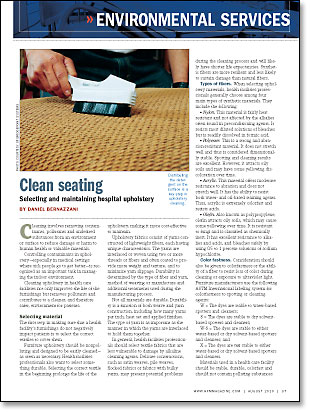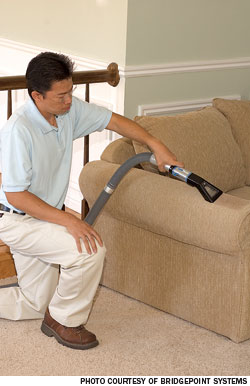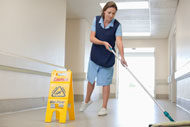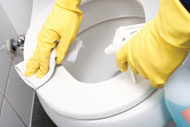 Cleaning involves removing contaminants, pollutants and undesired substances from an environment or surface to reduce damage or harm to human health or valuable materials.
Cleaning involves removing contaminants, pollutants and undesired substances from an environment or surface to reduce damage or harm to human health or valuable materials.
Controlling contaminants in upholstery—especially in medical settings where sick people go to get better—is recognized as an important task in managing the indoor environment.
Cleaning upholstery in health care facilities not only improves the life of the furnishings but removes pollutants and contributes to a cleaner, and therefore safer, environment for patients.
Selecting material
The first step in making sure that a health facility's furnishings do not negatively impact patients is to select the correct textiles to cover them.
Furniture upholstery should be nonpolluting and designed to be easily cleaned—as often as necessary. Health facilities professionals also want to select something durable. Selecting the correct textile in the beginning prolongs the life of the upholstery, making it more cost-effective to maintain.
Upholstery fabrics consist of yarns constructed of lightweight fibers, each having unique characteristics. The yarns are interlaced or woven using two or more threads or fibers and often coated to provide more weight and texture, and to minimize yarn slippage. Durability is determined by the type of fiber and yarn, method of weaving or manufacture and additional treatments used during the manufacturing process.
Not all materials are durable. Durability is a function of both weave and yarn construction, including how many yarns per inch, heat set and applied finishes. The type of yarn is as important as the manner in which the yarns are interlaced to hold them together.
In general, health facilities professionals should select textile fabrics that are less vulnerable to damage by alkaline cleaning agents. Delicate constructions, such as satin weaves, pile weaves, flocked fabrics or fabrics with bulky yarns, may present potential problems during the cleaning process and will likely have shorter life expectancies. Synthetic fibers are more resilient and less likely to sustain damage than natural fibers.
Types of fibers. When selecting upholstery materials, health facilities professionals generally choose among four main types of synthetic materials. They include the following:
• Nylon. This material is fairly heat resistant and not affected by the alkalies often found in preconditioning agents. It resists most diluted solutions of bleaches but is readily dissolved in formic acid.
• Polyester. This is a strong and abrasion-resistant material. It does not stretch well and thus is considered dimensionally stable. Spotting and cleaning results are excellent. However, it attracts oily soils and may have some yellowing discoloration over time.
• Acrylic. This material offers moderate resistance to abrasion and does not stretch well. It has the ability to resist both water- and oil-based staining agents. Thus, acrylic is extremely colorfast and resists acids.
• Olefin. Also known as polypropylene, olefin attracts oily soils, which may cause some yellowing over time. It is resistant to fungi and is classified as chemically inert. It has excellent resistance to alkalies and acids, and bleaches safely by using 0.5 to 1 percent solutions of sodium hypochlorite.
Color fastness. Consideration should also be given to colorfastness or the ability of a fiber to resist loss of color during cleaning or exposure to ultraviolet light. Furniture manufacturers use the following ASTM International labeling system for colorfastness to spotting or cleaning agents:
W = The dyes are stable to water-based spotters and cleaners;
S = The dyes are stable to dry solvent-based spotters and cleaners;
W-S = The dyes are stable to either water-based or dry solvent-based spotters and cleaners; and
X = The dyes are not stable to either water-based or dry solvent-based spotters and cleaners.
Materials used in a health care facility should be stable, durable, colorfast and should not contain polluting substances that can be emitted. Thus, it is recommended that health care facilities choose a fabric coded as W or W-S.

|
| Hot water extraction cleaning, or steam cleaning, is a popular method of upholstery maintenance. |
Additionally, consideration should be given to color selection—if it is too light or too dark, soiling may become obvious very quickly.
Cleaning and maintaining
A critical though often neglected responsibility of maintaining upholstery is conducting routine care. The guidelines presented in The Institute of Inspection, Cleaning and Restoration Certification (IICRC) S300—Standard and Reference Guide for Professional Upholstery Cleaning (www.iicrc.org/store) can assist in the maintenance of upholstered fabrics.
Controlling soil. Upholstered furniture is susceptible to soiling on arms and seat cushions as well as the upper inside back, headrests, pillows and skirt. Arm covers and rotating seat cushions frequently prolong fabric life and appearance. Advice on soil removal includes the following:
• Dry soil removal. Routinely vacuuming and brushing upholstery is recommended to remove dust and particulate soil. This enhances appearance and prolongs fabric life. Equally important, soil vacuumed from the fabric must not be allowed to re-enter the air within the structure and contribute to indoor environmental pollution.
• Immediate spotting. Most spots and spills can be easily removed if the excess is scooped up or blotted and treated immediately with plain water or neutral spotters. If ignored, these spots or components thereof may bond to fibers, possibly causing permanent stains. Immediate spot cleaning is essential.
Cleaning frequency. Upholstery should be cleaned approximately every six to 12 months, depending on the furniture's location, use and exposure to soiling. This is particularly important for furniture in a health care facility or other areas occupied by persons with allergies or severe respiratory sensitivity.
An analysis will help determine specialized maintenance and cleaning schedules. Furniture and fabric manufacturers recommend against waiting until severe soiling occurs before cleaning. The greater the soiling, the less the likelihood of restoring the original color, appearance and texture of the fabric, and the greater the adverse effect on indoor air quality.
Trained technicians should perform cleaning before soiling causes permanent damage to fibers, dyes or fabric texture. Dry soil, such as hair, lint, particle soil, dust and debris regularly should be vacuumed from the fabric to the fullest degree possible by using a high-quality vacuum cleaner equipped with a high-efficiency soil collector.
This procedure ensures that contaminants, pollutants and other unwanted substances are removed from the textile, reducing possible damage or harm to human health or valuable materials. This routine maintenance helps keep the furnishings in a more attractive state, while preventing premature wear.
Cleaning methods. The principles for cleaning upholstery include inspecting the fabric; testing the dye; removing dry soil; suspending the soil by using a chemical action, heat, agitation and time; removing the soil; setting the pile; and drying. There are a number of different types of cleaning methods that can be used, including the following:
• Absorbent compound. The absorbent compound method is a minimum moisture system used to clean moisture-sensitive or non-colorfast fabrics.
• Dry solvent cleaning. This is reserved primarily for delicate or non-colorfast fabrics that can be damaged using water-based cleaning processes. This process is not recommended for health care facilities.
• Dry foam cleaning. Also known as shampoo cleaning, this is a method of cleaning that follows dry soil removal through vacuuming. Once the dry soil is removed, a foaming detergent is applied using sprayers, sponges or hand- or mechanical-brush action.
• Hot water extraction cleaning. Hot water extraction, or steam cleaning, is a method that begins with dry soil removal followed by preconditioning. Then, hot water is applied to the fabric with detergent from a holding tank and extracted.
• Leather cleaning. When cleaning finished leather, the primary concern is control of the pH of the cleaning agent and application so that the finish is not damaged and natural oils in the leather are not removed.
A critical part
Regular furniture textile cleaning is a critical maintenance task in any health care facility and should be planned and implemented as part of a routine environmental services program.
Upholstery should be given a high priority and maintained by professionals trained in cleaning science who understand the fundamentals of textiles and know how to evaluate safety and hygiene, determine schedules for cleaning, and use proper chemicals and methods.
Ultimately, it is much less expensive to keep upholstery clean than it is to replace it.
Daniel Bernazzani is an indoor environmental professional and president of DryAdvise, Swampscott, Mass. He has chaired committees on environmental issues at the Institute of Inspection, Cleaning and Restoration Certification (IICRC) and has served as president and vice chairman of the IICRC's technical division. He can be reached atDan@DryAdvise.com.





